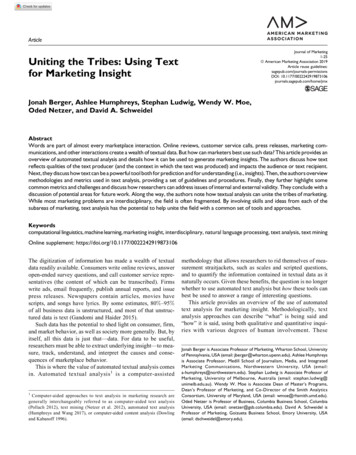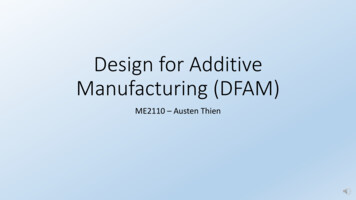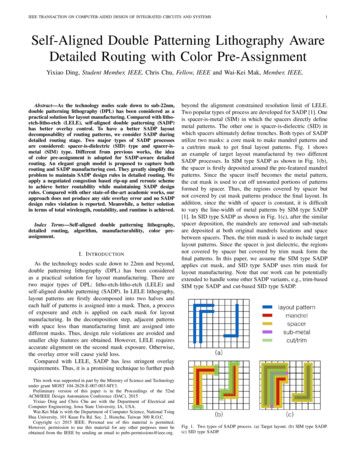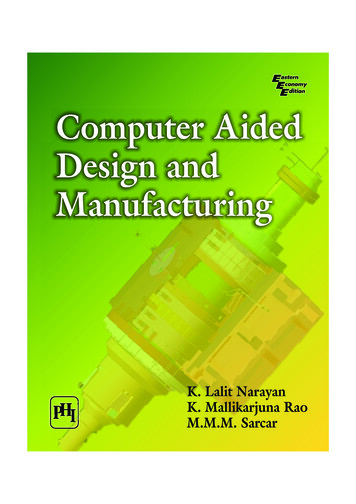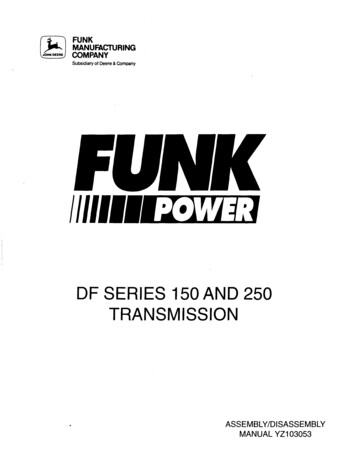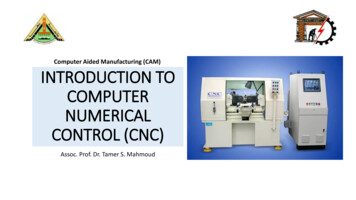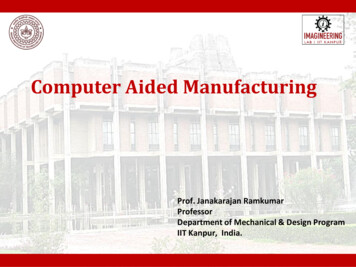
Transcription
Computer Aided ManufacturingProf. Janakarajan RamkumarProfessorDepartment of Mechanical & Design ProgramIIT Kanpur, India.
Contents Manufacturing Use of Computers Computer Applications (CAD, CAM, CAPP etc.) Design Process involved Manufacturing Systems and types Introduction to CIM Sub-systems of CIM Present Scenario Future Prospects
Manufacturing Manufacturing is the process of converting raw materials, components orparts into finished goods that meet a customer's expectations orspecifications. Manufacturing is a value-adding process allowing businesses to sellfinished products at a premium over the value of the raw materials used. It is a series of interrelated activities and operations involving design,material selection, planning, production, quality assurance, management,and marketing of discrete consumer and durable goods.
Manufacturing
Use of Computers1.A computer is a machine that can be instructed to carryout sequences of arithmetic or logical operations automaticallyvia computer programming.2.Modern computers have the ability to follow generalized sets ofoperations, called programs.3.These programs enable computers to perform an extremely widerange of ses-of-computers-in-different-fields/
Evaluation of Technology
Evaluation of Technology
Computer Applications CAD - computer aided design. The use of computer methodsto develop the geometric model of the product in threedimensional form, such that the geometric andmanufacturing requirements can be examined. CADD - computer aided design and drafting. Combining theCAD function with drafting to generate the productiondrawings of the part for the purpose of downstreamprocessing. CAE - computer aided engineering. The use of computermethods to support basic error checking, analysis,optimisation, manufacturability, etc., of a product design.
Computer Applications CAM - computer aided manufacturing. Generally refers tothe computer software used to develop the ComputerNumerical Control part programs for machining and otherprocessing applications. CAPP - computer aided process planning. The use ofcomputer to generate the process plans for the completemanufacture of products and parts. CATD - computer aided tool design. Computer assistance tobe used for developing the tools for manufacture such asjigs and fixtures, dies, and moulds.
Computer Applications CAP - computer aided planning. The use of computer formany of the planning functions such as materialrequirement planning, computer aided scheduling, etc. CAQ – Computer Aided Quality assurance. The use ofcomputers and computer controlled equipment forassessing the inspection methods and developing thequality control and assurance functions. CAT – Computer aided testing refers to the software toolsthat can take a system through its various phases ofoperations and examine the response against the expectedresults.
Computer-aided -aided technologies11
Design Process Design is an activity that needs to be well organised andshould take into account all influences that are likely to beresponsible for the success of the product underdevelopment.
Design Process Product Engineering Product functionsProduct SpecificationsConceptual designErgonomics and AestheticsStandardsDetailed DesignPrototype developmentTestingSimulationAnalysis
Design Process Manufacturing Engineering Process planningProcess sheetsRoute sheetsToolingCutting toolsJigs and FixturesDies and MouldsManufacturing Information GenerationCNC Part programmesRobot ProgrammesInspection (CMM) programmes
Stages of Design Process
Computer assistedDesign Process
Manufacturing Systems Manufacturing systems is a collection of integrated equipment andhuman resources, whose function is to perform one or more processingand/or assembly operations on a starting raw material, part, or set ofparts. It is a logical groupings of equipment and workers in the factory. Components of a Manufacturing System are:1.2.3.4.Production machinesMaterial handling systemComputer system to coordinate and/or control the preceding componentsHuman workers to operate and manage the system17
Manufacturing Systems18
Categories of ManufacturingSystems It is classified in three categories in terms of the human participationin the processes performed by the manufacturing system:1.Manual work system - a worker performing one or more taskswithout the aid of powered tools, but sometimes using handtools2.Worker-machine system - a worker operating poweredequipment3.Automated system - a process performed by a machine withoutdirect participation of a human19
Categories of ManufacturingSystems(a) Manual work system, (b) worker-machine system, and (c) fully automated system20
Manufacturing SupportSystemsManufacturing support involves a sequence of activities that consists offour functions:1.Business functions - sales and marketing, order entry, costaccounting, customer billing2.Product design - research and development, design engineering,prototype shop3.Manufacturing planning - process planning, production planning,MRP, capacity planning4.Manufacturing control - shop floor control, inventory control,quality control21
Manufacturing SupportSystems22
Sequence of Information-ProcessingActivities in a Manufacturing Firm23
Automation in ProductionSystems Automation is technology associated with the applications ofMechanical, electrical and computer based systems to operate andcontrol production Two categories of automation in the production system:1.Automation of manufacturing systems in the factory2.Computerization of the manufacturing support systems The two categories overlap because manufacturing support systemsare connected to the factory manufacturing systems.24
Automated ManufacturingSystemsExamples: Automated machine tools Transfer lines Automated assembly systems Industrial robots that perform processing or assembly operations Automated material handling and storage systems to integratemanufacturing operations Automatic inspection systems for quality control25
Automated ManufacturingSystemsCar Manufacturing ish26
Introduction to CIMWhat is CIM ?1.Computer-integrated manufacturing (CIM) is the reproduction process. This integration allows individual processes toexchange information with each other and initiate actions.2.Computer-integrated manufacturing (CIM) makes the use ofcomputer-controlled machineries and automation systems inmanufacturing products. CIM combines various technologies likeCAD and CAM to provide an error-free manufacturing process thatreduces manual labor and automates repetitive tasks.
Introduction to CIM1.The term "computer-integrated manufacturing" is both a method ofmanufacturing and the name of a computer-automated system inwhich individual engineering, production, marketing, and supportfunctions of a manufacturing enterprise are organized.2.In a CIM system functional areas such as design,analysis, planning, purchasing, cost accounting, inventory control,and distribution are linked through the computer with factory floorfunctions such as materials handling and management, providingdirect control and monitoring of all the operations.
Computer Assistance
Data flow in CIMYu et al., Manufacturing letters (2015)
CIM lanning-part-1/99645/?skin pcb
Processes InvolvedThe various processes involved in a CIM are listed as follows: Computer-aided design Prototype manufacture Determining the efficient method for manufacturing by calculating the costs andconsidering the production methods, volume of products, storage anddistribution Ordering of the necessary materials needed for the manufacturing process Computer-aided manufacturing of the products with the help of computernumerical controllers
Processes InvolvedThe various processes involved in a CIM are listed as follows: Quality controls at each phase of the development. Product assembly with the help of robots Quality check and automated storage Automatic distribution of products from the storage areas to awaitinglorries/trucks Automatic updating of logs, financial data and bills in the computer system.
Advantages of CIM1. Error Reduction2. Speed3. Flexibility4. Integration
Advantages of CIM1. Error ReductionElimination of human error in many assignment and reporting functionson factory floor operations drastically reduces the error rate.2.SpeedCIM environments reduce the time it takes to perform manufacturingfabrication and assembly, allowing quicker flow of product to customersand increased capacity.
Advantages of CIM3. FlexibilityWith CIM companies quickly react to market conditions and then returnto previous settings when market conditions change.4. IntegrationCIM offers a degree of integration that enables the flexibility, speed anderror reduction required to compete and lead markets. Integratingfactory floor operations with enterprise software enables employees todo higher value functions for their -practice-flexibility-in-your-business/
Usages of CIM1. Industrial and Production Engineering2. Mechanical Engineering3. Electronic Design Automation1)2)Printed Circuit Board designIntegrated Circuit designhttps://www.123rf.com/profile macrovector
Challenges1. Integration of components from different suppliers2. Data Integrity3. Process Control
Challenges1.Integration of components from different suppliers:When different machines, such as CNC, conveyors and robots, are usingdifferent communications protocols (In the case of AGVs, even differinglengths of time for charging the batteries) may cause problems.2. Data IntegrityThe higher the degree of automation, the more critical is the integrity ofthe data used to control the machines. While the CIM system saves onlabor of operating the machines, it requires extra human labor inensuring that there are proper safeguards for the data signals that areused to control the machines.
Challenges3. Process ControlComputers may be used to assist the human operators of themanufacturing facility, but there must always be a competent engineeron hand to handle circumstances which could not be foreseen by thedesigners of the control intman1.html
Sub-Systems in CIM:Some or all of the following subsystems may be found ina CIM operation:1. Computer-aided techniques2. Devices and equipments required3. Technologies
Sub-Systems in CIM:Computer Aided Design (CAD)Computer Aided Manufacturing (CAM)Flexible Manufacturing Systems (FMS)Computer Aided Process Planning (CAPP)Computer Aided Engineering (CAE)Computer-Aided Quality Assurance (CAQ)Production Planning and Control (PPC)Enterprise Resource Planning (ERP)
Sub-Systems in CIM:Devices and equipment required: CNC, Computer numerical controlled machine tools DNC, Direct numerical control machine tools PLCs, Programmable logic controllers Robotics Computers Software Controllers Networks Interfacing Monitoring equipment
Sub-Systems in CIM:Technologies: FMS, (flexible manufacturing system) ASRS, automated storage and retrieval system AGV, automated guided vehicle Robotics Automated conveyance systemsAutomated Guided Vehicles(AGV)https://gfycat.com/gifs/search/agvs
Product cycle in ComputerizedManufacturing environment
The common databases various forcomputerized applications
Present scenario1. Smart manufacturing2. Digital manufacturing3. Internet Of Things (IOT)4. Artificial Intelligence (AI)
Present scenario1. Smart manufacturing:Smartmanufacturingisabroadcategoryof manufacturing that employs computer-integrated manufacturing,high levels of adaptability and rapid design changes, digitalinformation technology, and more flexible technical workforcetraining. Other goals sometimes include fast changes in productionlevels based on demand, optimization of the supply chain, efficientproduction and o-the-future-quicker/
Present scenario2. Digital Manufacturing:Digital manufacturing is the use of an integrated, computer-basedsystem comprised of simulation, 3D visualization, analytics andcollaboration tools to create product and manufacturing processdefinitions simultaneously.Digital manufacturing evolved from manufacturing initiatives suchas design for manufacturability (DFM), computer-integratedmanufacturing (CIM), flexible manufacturing and leanmanufacturing that highlight the need for collaborative product andprocess gital-manufacturing/
Present scenario2. Digital /01/10/industry-4-0-with-digital-manufacturing/
Present scenario3. Internet Of Things (IOT):1.There are essentially two different roles that the IOT can play inmanufacturing. It can connect the “things” that make your product—machines and equipment—to potentially make your manufacturingprocesses run more smoothly.2.Or you can tap into data collected or generated by your products,making them “smart” products.3.IOT has multitudes of applications in manufacturing plants. It canfacilitate the production flow in a manufacturing plant, as IOTdevices automatically monitor development cycles, and managewarehouses as well as inventories.
Present scenario3. Internet Of Things (IOT):IOT in anufacturing
Present scenario4. Artificial Intelligence (AI) :Artificial intelligence technology is now making its way intomanufacturing.“AI will perform manufacturing, quality control, shorten design time,and reduce materials waste, improve production reuse, performpredictive maintenance, and more,” says Andrew Ng, the creator ofthe deep-learning Google Brain project and an adjunct professor ofcomputer science at Stanford esentations-and-report-available
Present scenario4. Artificial Intelligence (AI) nsforms-manufacturing
Future ProspectsCloud based manufacturing : Cloud models come as infrastructure, platform, and services.Manufacturers can opt for the solution of choice and strategizemigration in stages. This makes cloud a flexible and convenient choice. Cloud allows the synchronization of data from multiple sources into asingle dashboard. Hence it relieves executives from the burden ofmanually transferring data from one system to another.
Future ProspectsCloud based manufacturing turing-abstract-from-20 fig8 236671408
Overall cycle ofdevelopment
SummaryWhat is Manufacturing?What is the Use of Computers and there evaluation?Various Computer Applications (CAD, CAM, CAPP etc.)?Design Process involved with computers assistance? What is Manufacturing Systems and its types? What is CIM? Sub-systems of CIM What is Present Scenario? What are Future Prospects?
Thank You
Manufacturing support involves a sequence of activities that consists of four functions: 1. Business functions - sales and marketing, order entry, cost accounting, customer billing 2. Product design - research and development, design engineering, prototype shop 3. Manufacturing planning -
